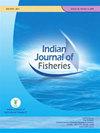生物铁纳米颗粒对鱼类体外寄生虫暹罗豚的抗寄生效果:体外研究
IF 0.3
4区 农林科学
Q4 FISHERIES
引用次数: 0
摘要
弓形虫是一种鱼类的体外寄生虫,在野生和养殖池塘中无处不在,给全球水产养殖业带来了严重的经济损失。随着水产养殖业的集约化程度不断提高,由于现有药物和化学品的疗效有限且副作用大,因此迫切需要发现新的治疗方法来治疗弓形虫病。金属纳米颗粒的使用在治疗多种寄生虫感染方面显示出良好的效果。本研究在体外条件下评估了生物合成的纳米铁粒子对阿古斯虫的抗寄生效果。以新鲜的洋紫荆叶提取物作为还原剂,对铁纳米颗粒(FeNPs)进行了生物合成,并使用紫外可见分光光度法、动态光散射(DLS)技术、zeta 电位测量、透射电子显微镜(TEM)、扫描电子显微镜(SEM)和傅立叶变换红外光谱(FT-IR)对其进行了表征。为了评估体外试验中 FeNPs 的抗寄生虫功效,将 10 只成虫和幼虫分别放入 20 毫升 1.00、1.25、1.50、1.75 和 2.00 毫克毫升/升五种不同浓度的 FeNPs 试验溶液中进行 6 小时的试验,成虫试验溶液一式三份,对照组为 0.75、1.00、1.25、1.50 和 1.75 毫克毫升/升,幼虫试验溶液一式三份,对照组为 0.75、1.00、1.25、1.50 和 1.75 毫克毫升/升。在 370-400 nm 的紫外范围内测量了 FeNPs 的形成。DLS 显示 FeNPs 的平均粒径为 119.8 nm,多分散指数为 0.311。Zeta 电位测量结果显示其表面电荷为负值(-11.3 mV),而 SEM 和 TEM 显微照片则显示合成的纳米颗粒近似球形,大小在 60-270 nm 之间。此外,傅立叶变换红外光谱显示存在 Fe-O、N=O 和 O-H 基团。两种情况下的杀菌效果都与浓度有关。对幼虫和成虫而言,FeNPs 在 1.75 毫克毫升/毫升和 2.00 毫克毫升/毫升的浓度下具有最高的杀箭毒活性,在 6 小时内分别导致 100% 和 87% 的箭毒死亡,而对照组在 16 小时内没有任何死亡记录。本研究结果表明,用生物合成的 FeNPs 进行短期水浴处理可有效杀灭箭毒寄生虫。然而,还需要进一步的研究来评估其在体内条件下的治疗潜力。关键词:弓形虫病 厦门弓形虫 纳米铁颗粒 杀寄生虫活性本文章由计算机程序翻译,如有差异,请以英文原文为准。
Antiparasitic effect of biogenic iron nanoparticles against the fish ectoparasite Argulus siamensis: In vitro study
Argulus, an ectoparasite of fish which is ubiquitous in wild and culture ponds, poses a majorchallenge with severe economic losses to the global aquaculture industry. With the increasein intensification of aquaculture practices, there is a dire need to discover new therapeuticoptions in the treatment of argulosis owing to the limited effectiveness of existing drugsand chemicals and their significant side effects. The use of metal nanoparticles hasshown promising results in the management of several parasitic infections. In this prelude,antiparasitic effect of biosynthesised iron nanoparticles was evaluated against Argulussiamensis under in vitro condition. Iron nanoparticles (FeNPs) were biosynthesised usingfresh Bauhinia racemosa leaf extract as a reducing agent and were characterised usingUV-VIS spectrophotometry, dynamic light scattering (DLS) technique, zeta potentialmeasurements, transmission electron microscopy (TEM), scanning electron microscopy(SEM), and fourier transform-infrared spectroscopy (FT-IR). For estimating antiparasiticefficacy of FeNPs under in vitro test, ten adult and juvenile parasites each were challengedfor 6 h separately in 20 ml of five different concentrations of FeNPs test solutions viz. 1.00,1.25, 1.50, 1.75 and 2.00 mg ml-1 in triplicate along with control groups for adults whereas,for juveniles, it was 0.75, 1.00, 1.25, 1.50 and 1.75 mg ml-1. Formation of FeNPs wasmeasured in 370-400 nm UV range. DLS showed an average FeNPs particle size of 119.8 nmwith a polydispersity index of 0.311. Zeta potential measurements showed negative surfacecharges (-11.3 mV) whereas, SEM and TEM micrographs revealed synthesised nanoparticleswere nearly spherical and size ranged from 60-270 nm. Further, FT-IR spectrum showed thepresence of Fe-O, N=O and O-H groups. Argulocidal effectiveness in both cases was foundto be concentration-dependent. The highest argulocidal activity of FeNPs was observed atconcentration of 1.75 mg ml-1 for juveniles and 2.00 mg ml-1 for adult argulids which led to100 and 87% mortality, respectively, in 6 h, however no mortality was recorded in controlgroup up to 16 h. Furthermore, the calculated 6 h-EC50 of biosynthesised FeNPs for juvenileand adult argulid parasites was determined as 0.97 and 1.27 mg ml-1. Results of the presentstudy showed that short term bath treatment with biosynthesised FeNPs is effective againstargulid parasites. However, further research is required to evaluate its therapeutic potentialunder in vivo condition. Keywords:Argulosis, Argulus siamensis, Iron nanoparticles,Parasiticidal activity
求助全文
通过发布文献求助,成功后即可免费获取论文全文。
去求助
来源期刊

Indian Journal of Fisheries
FISHERIES-
CiteScore
0.90
自引率
20.00%
发文量
0
审稿时长
6-12 weeks
期刊介绍:
Indian Journal of Fisheries is published quarterly by the Indian Council of Agricultural Research (ICAR), New Delhi. Original contributions in the field of Fish and fisheries science are considered for publication in the Journal. The material submitted must be unpublished and not under consideration for publication elsewhere.
Papers based on research which kills or damages any species, regarded as thratened/ endangered by IUCN crieteria or is as such listed in the Red Data Book appropriate to the geographic area concerned, will not be accepted by the Journal, unless the work has clear conservation objectives.
 求助内容:
求助内容: 应助结果提醒方式:
应助结果提醒方式:


